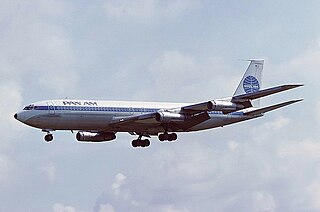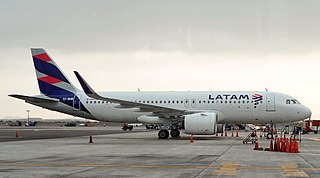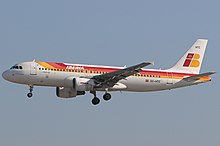
Josep Tarradellas Barcelona–El Prat Airport, and also known as El Prat Airport, is an international airport located 15 km (9.3 mi) southwest of the centre of Barcelona, lying in the municipalities of El Prat de Llobregat, Viladecans, and Sant Boi, in Catalonia, Spain.

Eastern Air Lines Flight 66 was a regularly scheduled flight from New Orleans to New York City that crashed on June 24, 1975 while on approach to New York's John F. Kennedy International Airport, killing 113 of the 124 people on board. The crash was determined to be caused by wind shear caused by a microburst, but the failure of the airport and the flight crew to recognize the severe weather hazard was also a contributing factor.

USAir Flight 1016 was a regularly scheduled flight in the southeastern United States, between Columbia, South Carolina, and Charlotte, North Carolina. On July 2, 1994, the flight encountered heavy thunderstorms and microburst-induced windshear while attempting to land, and crashed into heavy trees and a private residence near the airport. The crash and ensuing fire caused 37 fatalities and seriously injured twenty others.

Seville Airport is the sixth busiest inland airport in Spain. It is the main international airport serving Western Andalusia in southern Spain, and neighbouring provinces. The airport has flight connections to 42 destinations around Europe and Northern Africa, and handled 7,544,473 passengers in 2019. It serves as a base for the low-cost carriers Vueling and Ryanair. It is 10 kilometres (6.2 mi) east of central Seville, and some 110 kilometres (68 mi) north-east of Costa de la Luz. Seville Airport is also known as San Pablo Airport to distinguish it from the older Tablada Aerodrome, which was in operation as a military aerodrome until 1990.

Armavia Flight 967 was a scheduled international passenger flight operated by Armavia from Zvartnots International Airport, Zvarnots in Armenia to Sochi, a Black Sea coastal resort city in Russia. On 3 May 2006, the aircraft operating the route, an Airbus A320-200, crashed into the sea while attempting a go-around following its first approach to Sochi airport; all 113 aboard were killed. The accident was the first major commercial airline crash in 2006. It was Armavia's first and only fatal crash.
Iberia Líneas Aéreas de España, S.A., usually shortened to Iberia, is the largest airline of Spain, based in Madrid.

Lufthansa Flight 2904 was an Airbus A320-200 flying from Frankfurt, Germany to Warsaw, Poland that overran the runway at Okęcie International Airport on 14 September 1993.

Britannia Airways Flight 226A was an international passenger flight from Cardiff, Wales to Girona, Spain, operated by charter airliner Britannia Airways. On 14 September 1999, the Boeing 757-204 aircraft suffered a crash landing and broke apart during a thunderstorm in Girona-Costa Brava Airport. Of the 236 passengers and nine crew on board, two were seriously injured and 41 sustained minor injuries. One of the passengers who had apparently sustained only minor injuries died five days later of unsuspected internal injuries. The aircraft involved in the crash, Boeing 757-204 registration G-BYAG, was damaged beyond economical repair and scrapped.

Indian Airlines Flight 605 was a scheduled domestic passenger flight from Bombay to Bangalore. On 14 February 1990, an Airbus A320-231 registered as VT-EPN, crashed onto a golf course while attempting to land at Bangalore, killing 92 of 146 people on board.

TACA Flight 390 was a scheduled flight on May 30, 2008, by TACA International from San Salvador, El Salvador, to Miami, Florida, United States, with intermediate stops at Tegucigalpa and San Pedro Sula in Honduras. The aircraft, an Airbus A320-233, overran the runway after landing at Tegucigalpa's Toncontín International Airport and rolled out into a street, crashing into an embankment and smashing several cars in the process.

Pan Am Flight 806 was an international scheduled flight from Auckland, New Zealand, to Los Angeles, California, with intermediate stops at Pago Pago, American Samoa and Honolulu, Hawaii. On January 30, 1974, the Boeing 707 Clipper Radiant crashed on approach to Pago Pago International Airport, killing 87 passengers and ten crew members.

Iberia Flight 610 was a scheduled domestic passenger flight from Madrid to Bilbao, Spain. On 19 February 1985, a Boeing 727-200 operating the flight crashed into a ravine after one of its wings sliced a television antenna on the summit of Mount Oiz in Biscay during an approach to Bilbao Airport. All 141 passengers and 7 crew on board died. The crash is the deadliest aviation disaster in both the Basque Country and Iberia history.

On 4 April 2011, Georgian Airways Flight 834, a Bombardier CRJ100 passenger jet of Georgian Airways operating a domestic flight from Kisangani to Kinshasa in Democratic Republic of Congo (DRC) crashed while attempting to land at Kinshasa Airport. The aircraft, which was chartered by the United Nations, was trying to land during a thunderstorm. Of the 33 people on board, only one person survived. It remains as United Nations' deadliest aviation disaster. It is also the third deadliest air disaster involving the CRJ100/200, behind Comair Flight 5191 and China Eastern Airlines Flight 5210.

Bhoja Air Flight 213 was a domestic scheduled passenger flight operated by Pakistani airline Bhoja Air from Karachi to Islamabad. On 20 April 2012, the Boeing 737-236A aircraft serving the route crashed in bad weather during its final approach to land. All 121 passengers and 6 crew members aboard were killed. With 127 deaths, it remains as the second deadliest air disaster in Pakistan.

Air Canada Flight 624 was a scheduled Canadian domestic passenger flight from Toronto Pearson International Airport to Halifax Stanfield International Airport in Halifax, Nova Scotia. During heavy snow and poor visibility, at 00:43 ADT on 29 March 2015, the Airbus A320-211 landed short of the runway and was severely damaged. Twenty-six people were injured.

Asiana Airlines Flight 162 was a regular short-haul international passenger flight from Incheon International Airport near Seoul, South Korea, to Hiroshima Airport in Hiroshima, Japan. On 14 April 2015, the Airbus A320-232 aircraft touched down short of the runway, struck the localizer array, skidded onto the runway on its tail, and spun 120 degrees before finally coming to a rest on the grass, opposite the terminal building. The aircraft suffered substantial damage to the left wing and engine. Of the 82 people aboard, 27 were injured, one seriously.

Aeroméxico Connect Flight 2431 (SLI2431/5D2431) was a Mexican domestic scheduled passenger flight bound for Mexico City that crashed on takeoff from Durango International Airport on July 31, 2018. Shortly after becoming airborne, the plane encountered sudden wind shear caused by a microburst. The plane rapidly lost speed and altitude and impacted the runway, detaching the engines and skidding to a halt about 1,000 feet (300 m) beyond the runway. The plane caught fire and was destroyed. All 103 people on board survived, but 39 passengers and crew members were injured.

LATAM Perú Flight 2213 (LP2213/LPE2213) was a scheduled domestic passenger flight in Peru from Lima to Juliaca. On 18 November 2022, the Airbus A320neo was taking off from Jorge Chávez International Airport when it collided with a fire engine that was crossing the runway, killing two firefighters and injuring a third, who died of his injuries seven months later. 40 passengers were injured.

















